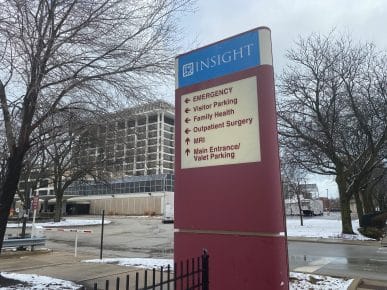He sat in the front row of the auditorium among other executives, celebrating the grand opening of Insight Hospital and Medical Center. With youthful looks, he walked to the podium to speak after being introduced as the hospital’s chief medical officer.
He is Dr. Dillon Bannis. He’s young, Black and just 36 years old. He rose from being a medical intern at the former Mercy Hospital to forge a successful career as a physician. Today he has a bigger title and role as part of Insight’s 13-member executive leadership team.
The team leads a 170-year-old facility in Bronzeville, once the struggling Mercy Hospital, which filed bankruptcy in 2021 and left the neighborhood on the brink of losing its only hospital. Community leaders, activists and even some Mercy hospital staff members spoke out to keep the hospital from the same fate as the 120-year-old Michael Reese Hospital, which closed in 2009.
Then came Insight Chicago, which purchased the facility for $1 from Mercy’s owner, Trinity Health.
On Monday, March 7, the hospital officially celebrated its opening and a recent state-approval decision to allow ambulances to bring patients to the facility. Guests dined on catered food served during a ceremony that included live entertainment.
Since it took over the facility last June, Insight Hospital has treated nearly 12,000 drive-up and walk-in emergency room patients, according to Dr. Anita Goyal, chairwoman of the hospital’s emergency medicine department. Goyal said typical emergency rooms with ambulance services serve 25,000 patients every year. She said at least 20 percent of those patients were uninsured.
One year after its opening, community leaders and elected officials praised the hospital for its commitment to the Bronzeville neighborhood and for achieving equity in health care for Blacks and minority patients.
“Even before COVID, Black Chicagoans lived nine years less than white Chicagoans,” said Dr. Allison Arwady, commissioner for the Chicago Department of Public Health.
“And we’ve seen life expectancy dropping the fastest for Latinx Chicagoans. We’ve seen it drop for Asian American Chicagoans. The only group prior to COVID that we were not seeing the life expectancy drop was white Chicagoans. That is unacceptable and the result of systemic and ongoing racism.”
State Senator Mattie Hunter said, “We had only one goal, and that’s to keep this hospital open. We need to bring back up this hospital the way it was five, 10 years ago.”
State Representative Lamont Robinson said, “because of the steadfast work of the community, we did it. The community saved this hospital.”
Many Insight Hospital staff members are former Mercy employees. One of them is Dr. Bannis, the facility’s chief medical officer who’s also a practicing physician there.
He grew up in Florida, where he graduated from Coral Springs High School in Broward County. He obtained his undergraduate degree from Florida Atlantic University (FAU) and a medical degree from the University of Miami’s prestigious Leonard M. Miller School of Medicine.

“I always wanted to fix things,” Dr. Bannis told the Crusader.
“I think everybody has that within them. It’s just a matter of aligning your motivation for doing things with a career. That’s where that synergy happens where people become happy.
Bannis explained his calling to medicine saying, “I loved tinkering with things as a kid, so being a doctor is one of those things that as a 10-year-old I thought I can fix people and fix things. My career path took a couple of different turns. I love mathematics, I love engineering. But I also have a passion for people.”
After medical school, Bannis served his internship and residency at Mercy. He then served as an attending physician at the hospital, specializing in obstetrics and gynecology, a branch of medicine that provides health care for women.
When Insight Hospital formed its executive leadership team, it appointed Bannis as its chief medical officer. The post is held by an established physician who advises and leads a team of medical experts on matters of public health importance.
Bannis told the Crusader that his executive role also involves a “lot of bridge-building, communication and advocacy.”
Commenting further Bannis noted, “But the primary responsibility is toward the patients and making sure clinical care and administrative [responsibilities] are aligned.”
The youthful administrator said he initially did not want the promotion as chief medical officer. He told the Crusader that he believed that he was already committed to serve the community as a doctor.
“I wrestled with that promotion a little because at the time I felt I was doing everything that I possibly could [to serve the needs of the community]. I didn’t have enough time to do anything else.
“Then I went back and thought about the actual mission [of the position] and I thought about the reason why I stayed here in the first place. When I thought of those things and went outside of myself and stopped thinking about my time and my aspirations, I really started thinking about what the community actually needs and how I can best serve that instead of myself.”
One difficult moment during Bannis’ career at Mercy came in 2018, when a man killed two employees and a Chicago police officer during a shooting rampage. The man, Juan Lopez, 32, shot and killed Dr. Tamara O’Neal, 38, a rising Black doctor who was Lopez’s former fiancée. Dayna Less, a 25-year-old pharmacy resident also died, along with a Chicago police officer, 28-year-old Samuel Jimenez.
“That was a dark time,” Bannis said. “Honestly, that could either break you or make you want to quit. It can also draw you a little closer to your morals and belief in God, and that’s the route I ended up taking.”
Bannis said those days are behind him as he looks forward to being part of Insight Hospital’s future. “Insight is going to be the cornerstone of the community. It’s going to be a pillar in the Bronzeville neighborhood.
“I think a lot of times people throw out the moniker of the ‘safety net hospital’ that suggests we’re negative or substandard,” Bannis said. “For us, we always want to make sure that the care that we deliver and the people that we touch is the best that we can give.”






